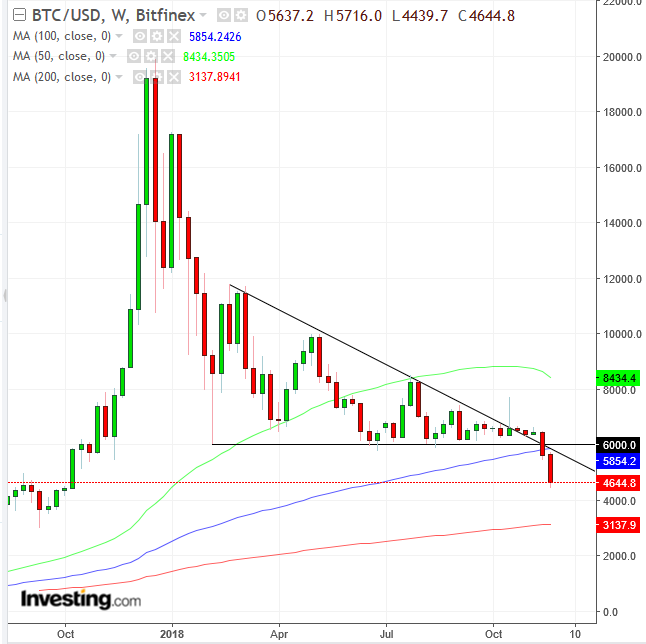- Tech rout pushes global stocks, US futures lower
- 10-year Treasury yields set for reversal
- Dollar fights to remain in uptrend
- BTC falls toward $4,600, hitting a 13-month low
Key Events
European stocks and futures on the S&P 500, Dow and NASDAQ 100 joined Asian equities in a selloff this morning, after a sharp decline in tech shares dragged US equities significantly lower on Monday. The dollar is fighting to maintain its mid-term uptrend, and the yield on 10-year Treasurys is set to complete a reversal.
The Stoxx Europe 600 slipped lower alongside technology and banks shares today after US software developers and semiconductor manufacturers weighed on the S&P 500 yesterday.

After yesterday's, arrest of Carlos Ghosn, Nissan’s chairman, on charges of financial misconduct added to the US-led selling, during today's Asian session Nissan Motor shares (T:7201) plunged 6.41 percent. However, dip buyers pared losses to 5.45 percent. The Japanese car maker's stock fell to the lowest level in 16 months, within 7 percent of the long-term uptrend line since the 2009 bottom.
China shares underperformed, with the Shanghai Composite dropping 2.13 percent and the SZSE Component giving up 2.83 percent. Hong Kong’s Hang Seng fell 2.03 percent. Australia’s S&P/ASX 200 outperformed, falling the least, 0.38 percent, reversing yesterday's underperformance.
Global Financial Affairs

Yesterday, big tech continued to wreak havoc on broader US markets. The latest worries pressuring the sector were concerns about potential new regulations for the industry, even as the trade dispute saga escalated in the background. All major benchmark indices were down at least 1.5 percent, with the NASDAQ Composite and the NASDAQ 100 leading losses, tumbling of over 3 percent.
Technically, the NASDAQ Composite completed a symmetrical triangle, bearish in a downtrend, with a one-percent downside breakout. The NASDAQ 100 slipped to its lowest level since April on renewed fears that trade jitters will impact global demand and cause disruptions in the supply chains of the major technology companies, which have led the US bull market for almost ten years.
Meanwhile, the most significant drop in homebuilder sentiment in more than four years hammered the housing sector as well.
Also, a slowdown in consumer sales exacerbated the background risk-off sentiment, adding to the hurdles that are currently holding equities back from returning to pre-October correction levels and resuming their long-term uptrends. More specifically, downbeat figures highlighted some flows in the previously stellar macroeconomic data, adding to fears of a deeper market correction. Ray Dalio, founder of Bridgewater Associates, the world’s largest hedge fund firm, said that investors should expect low returns for a long time after years of low interest rates and quantitative easing.

The yield on 10-year notes provided a downside breakout to a double-top reversal, as investors rotated out of equities and into Treasurys.

The dollar bounced off the day’s lows, forming a bullish hammer, as it struggles to remain within its ascending channel. Yesterday we posted a buy recommendation.
The pound stabilized after UK Prime Minister Theresa May's moved to appeal to business leaders to back her Brexit proposal. Rumors of a plot to oust her are abating.

Bitcoin tumbled lower for a second day, hitting $4,623 for the first time since October 2017—in line with our forecast from last week.

Crude dropped below $57, giving up a 1.16 percent advance to $57.38, though it later rebounded. The pattern was forming a rising flag, bearish after a decline. Also, after the 50 DMA crossed below the 100 DMA, it’s threatening to do the same to the 200 DMA. The commodity is struggling to find direction as some of the bigger players in the market—Saudi Arabia, OPEC, Russia, the US—are trying to re-define their position on the global stage.
Up Ahead
- Bank of England Governor Mark Carney appears before the UK Parliament on Tuesday
- October figures on US building permits and existing home sales will come out on Tuesday and Wednesday respectively
- Core durable goods orders data for October is due on Wednesday
- US markets will see a holiday-shortened week, with Black Friday kicking off the holiday shopping season after Thanksgiving break
Market Moves
Stocks
- The Stoxx Europe 600 fell 0.7 percent as of 8:13 a.m. London time, hitting the lowest level in more than three weeks with its fifth consecutive decline.
- Futures on the S&P 500 slipped 0.5 percent to the lowest level in three weeks.
- Italy’s FTSE MIB dropped 0.5 percent, hitting the lowest level in more than three weeks with its fifth consecutive decline.
- The UK’s FTSE 100 slid 0.4 percent.
- The MSCI All-Country World Index edged 0.3 percent lower to the lowest level in almost three weeks.
Currencies
- The Bloomberg Dollar Spot Index fell 0.1 percent to the lowest in more than a week.
- The euro gained 0.1 percent, hitting the strongest level in almost four weeks with its sixth straight advance.
- The British pound climbed 0.2 percent to $1.2874.
- The Japanese yen increased 0.1 percent to 112.44 per dollar, the strongest level in three weeks.
- The Hong Kong dollar climbed less than 0.05 percent to 7.8319 per dollar.
Bonds
- The yield on 10-year Treasuries dropped less than one basis point to 3.06 percent, hitting the lowest level in more than seven weeks with its eighth straight decline.
- Britain’s 10-year yield gained one basis point to 1.378 percent.
- Germany’s 10-year yield climbed less than one basis point to 0.38 percent.
Commodities
- West Texas Intermediate crude declined 0.7 percent to $56.81 a barrel.
- The Bloomberg Commodity Index slid 0.7 percent to 84.27.
- Natural gas fell 3.8 percent to $4.52 per MMBtu.
